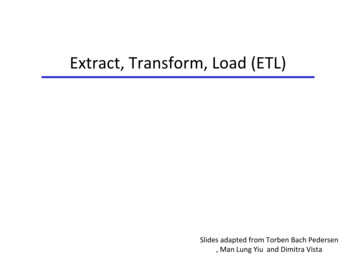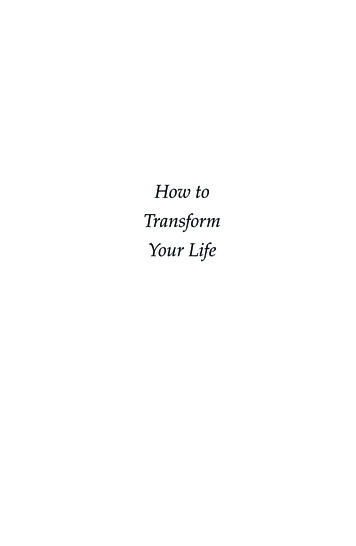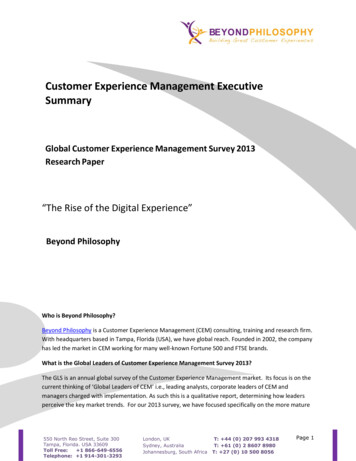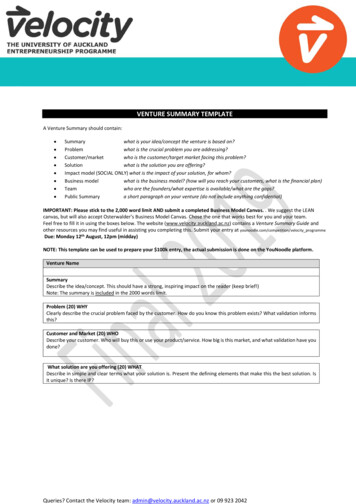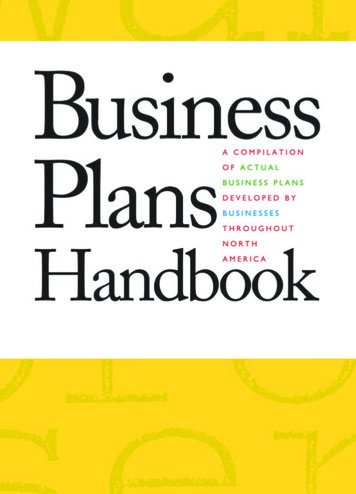
Transcription
INFLUENCERSBOOK SUMMARYThis has been one of my favourite books of the last 5 years. It isresearch based, clearly written, with lots of practical examples andstories. I find myself thinking and using the model all the time.Influence is an important topic. This book goes beyond persuasionand selling techniques and looks at behavioural change – othersand ours.Whether you’re a CEO, a parent, or just someone who wants tomake a difference, you probably wish you had more influence inyour life.The truth is we all want to be more influential. Hardly a day passesthat we don’t try to exert influence on others to change theirbehaviour. We also spend a lot of time trying to influence ourselvesto make sacrifices in the short-term, in hopes of seeing payoffsdown the road. We regularly try to convince ourselves to foregoshort-term pleasures in order to lose weight or save more money.We struggle to take charge of our tempers around our children. Westrive to become a relevant voice in our friends’ lives, and try tomodel good behaviours as best we can.Consciously or not, we never stop trying to exert influence. It’s just what we do.Unfortunately, in spite of the fact that barely an hour goes by each day when we’re not attempting to influenceourselves, or folks around us, most of us are pretty darn lousy at it. Even among the minority of us who would perhapsbe considered “influential” by our peers, most of the time we’re just “winging it.” We may have acquired some of thebasic tools to be moderately influential, but we’re rarely conscious of what we’re doing, and thus we tend to apply ourskills inconsistently, and ineffectively. In short, there’s lots of room for improvement.
On the market today are hundreds, if not thousands, of self-help books that claim to teach us how to “win friends andinfluence people.” Some of these offerings are better than others. But for the most part, these books are based onshowing how to improve our verbal persuasion skills, or employ slick negotiation tactics.Yes, having good communication skills is important. But according to the authors of a groundbreaking new bookInfluencer: the Power to Change Anything, you’ll never convince anyone to make a real, lasting change through merewords alone.Many people when they encounter a difficult problem defer to an old prayer for guidance, which is what the authorscall “the serenity trap” (p.4).“We ask for the serenity to accept the things we cannot change, the courage to change the things you can,and the wisdom to know the difference”.We do not bring forth change by fixing specific problems or by verbal persuasion, as many have believed for theirentire life. The authors believe therein lays the problem; we try a few comfortable strategies to fix our problem, andwhen they don’t work, we give up and try to control the aspects of our lives that we can. The premise of the Influenceris that all problems, from every facet of our lives, can be solved “because these problems don’t require solutions thatdefy the laws of nature; they require people to act differently” (p.4). When we learn methods and apply strategies daily,we expand our influence and bring forth change into every aspect of our lives.
ABOUT THE AUTHORSKerry Patterson, Joseph Grenny, David Maxfield, Ron McMillan, and Al Switzler. They’re founders of VitalSmarts, a leaderin corporate training services that’s taught more than two million people and worked with dozens of Fortune 500 companies. They’re also the co-authors of the New York Times bestseller Crucial Conversations, and its hit follow-up CrucialConfrontations, which showed many thousands of people how to create dramatic, long-lasting change at work, athome, and in their communities by implementing proven influence strategies.The authors’ latest book, Influencer, taps into the skills of hundreds of successful change agents from corporateAmerica — and from organizations around the world — and combines them with decades of top-caliber social scienceresearch. Their lofty goal was to develop a coherent, concise and portable model for changing behaviours; a modelthat virtually anyone could easily learn, and apply.Influencer is divided into two parts. The first part sets the stage, and explains why changing people’s actions mustalways start by focusing on people’s behaviours. The second part of the book goes on to identify, and then teach ushow to effectively manipulate, the six timeless sources of influence that most affect people’s behaviours, namely:Values, Skills, Support, Teamwork, Incentives, and the Environment. Best of all, the authors show us how to locate thesesix sources of influence using interesting, real life examples, and then explain step-by-step how to apply them to solvethe most intractable problems.
PART I: THE POWER TO CHANGE ANYTHINGThere are many global examples in order to determine factors of influence. They also researched the work of Dr.Albert Bandura, who studied how powerfully behaviour is shaped from the observation of others, not by usingrewards or punishments. Studying a person’s critical moments from their lives or being self-aware is not necessary inorder to invoke change. The influencers came to the conclusion that if you understand the science behind behaviours, you can change remarkably resistant behaviours. “All of this is important to know because if you want tochange the world, you eventually have to change how people behave. And if you want to change how they behave,you have to first change how they think”(p.20). This means that we as people, can learn how to influence others, it isnot because of a character flaw or lack of motivation. We need to see because of a character flaw or lack of motivation. We need to see ourselves as influencers, and study the masters in order to learn.To be clear, Patterson, Grenny, Maxfield, McMillan, and Switzler didn’t discover a magic bullet. Rather, they uncovereda common set of tools that have been proven effective in different combinations, under different circumstances.The authors also came to understand that the world’s greatest influencers start by focusing on behaviours. Theydon’t seek to apply an influence strategy until they have clearly defined the underlying behaviour they are targeting.This is different than zeroing-in on outcomes. Effective influencers understand they must focus on the behavioursthat enable, or impair, the desired outcome.
“All too often,” say the authors, “failed attempts at influencing others are the direct result of a ‘means/ends’ confusion,where the desired outcome may be obvious, but the means for achieving it remains unclear.” To make their point, theauthors cite the example of Ethna Reid, a highly-regarded educator who studied the key essential behaviours thatseparate effective from non-effective teachers. For five years, Dr. Reid and her team studied and coded the behavioursof high and low performing teachers. In the end they found two critical behaviours that separated the two groups.Specifically, they found that high performing teachers typically distinguish themselves by rewarding their students’positive performance more frequently. They also discovered that high performing teachers are better at quickly shifting gears between (1) teaching new concepts, and (2) assessing whether their students are grasping those concepts,in order to make immediate, on-the-spot adjustments to their teaching approach, if needed.
STEP 1: CLARIFY MEASURABLE RESULTSBegin with the end in mind. The most important part of leading change is understanding what you are leadingtowards, when it will happen, and being able to track progress towards it. Use both quantitative and qualitativemetrics.Don’t waste time on how to create change until you’ve clarified what you want, why you want it, and when you wantit. An effective result is:1. Specific and measurable. It is quantitative not qualitative.2. What you really want. It’s the outcome that matters.3. Time bound. It comes with a completion date.Defining success in an easy way to measure it. Begin with the end in mind. The most important part of leading change isunderstanding what you are leading towards, when it will happen, and being able to track progress towards it. Useboth quantitative and qualitative metrics.As a hypothetical, assume you are leading a culture shift within your nonprofit organization to promote innovationand instill passion to better engage donors. Quantitative measurements include: Increases in number of donors,amount per donor, recurring donations, rate of recurring donations. Qualitative results include stories of inspiration,new programs funded, stronger teams, etc.
THE 3 MISTAKES PEOPLE MAKE:1. FUZZY AND UNCOMPELLING GOALSThey start with a vague sense of what they want people to achieve or do. “Empower our employees”, “Be a highperforming Operational center” “Improving customer service”.What we want to design is clear goals, aimed at a compelling target. Something that engages more than just the brainbut also the emotions.As an example the authors use, Martin Burt started Fundacion Paraguay’s 30 years ago. The aim was to provide Paraguays poor with easy access to credit as a means of helping them climb out of poverty. Burt was troubled, too few weregetting out of poverty through this method. No longer would they focus on number of loans they processed (a somewhat uncompeling goal), they changed it to be “Beginning April 2011, “Our goal is to help 5000 poor families to earn 5 per day per person or more before the end of the year.”The effects of this clear goal was immediate and set of a whole chain of events. It influenced the way people saw theirjobs. It influenced how the loan officers needed to work with their clients. Burt announced on December 31, 2011 thatover 6000 families had achieved this goal.2. INFREQUENT OR NO MEASURESUnsuccessful change strategies or programs rarely develop credible measures against which to match their intentionsYou have to pick a measure that represents the goal or idea. We need to go beyond anecdotal evidence that things arebetter. A measure won’t drive behaviour and it certainly wont maintain attention if it’s rarely assessed –especially ifother measures are taken, discussed and fretted over a hundred time more frequently.Of course it takes effort and energy to collect and present data, leaders often complain it takes too much effort to do.Here is an issue, leaders don’t see that measurement is an integral part of the change effort and done correctly, itinforms and drives behaviour.Let’s say a restaurant measured revenue daily, but customer experience yearly. Revenue would drive the leaders attention and customer experience would get a ritualized yearly review. If you want to influence behaviour,it must be measured frequently.Leaders assume that measurements as separate from influence. It isn’t. Measurement is integral part of the changeeffort, and done correctly, it informs and drives behaviour.3. BAD MEASURESEven when they do take measure, many who fail often drive the wrong behaviour by measuring the wrong variable.In Communist Russia the Soviets didn’t have ways to measure profit, or customer satisfaction. What they could and didmeasure was output. They measured output by weight. So a nail factory switched from making the nails that peopleneeded to huge and heavy railway spikes. When the leaders learnt this they switched to number of units. So the nailfactory switched to tiny, almost unless nails.
STEP 2. FIND VITAL BEHAVIOURSPatterson et al. (2008) maintained that before a person can influence change, they must first decide what the they aretrying to change. The first step of identifying the key behaviours to develop influence strategies is a critical componentin successful change. The authors asserted that beginning with the end goal in mind, and being able to track progressis essential, and they suggest both qualitative and quantitative methods of data collection. It is extremely importantto ensure that there is no confusion between outcomes and behaviours when planning for change. What you want toachieve is the end goal, it is necessary to learn what actually needs to be done in order to influence change. Theauthors also warned of advice from the experts. If you can’t immediately figure out what to do, then the advice is tooabstract, and may lead to an unclear course of action. The second step in creating a focused plan for change is thesearch for v vital behaviours. Once vital behaviours are identified, a plan to change t these behaviours is developed,and problems seem to disappear. In all o of the examples provided by Patterson et al. (2008), there was an intensesearch for the best practices available for their particular d o domain. Not only were the top performers studied, othersthat e were not quite as good were also observed, in order to identify key be behaviours that set the groups apart. Theresults of the observations w e were studied, and the researchers then took their findings and taught t h e them to asmall experimental group, and noted the changes.If theresearchers were correct, then both the vital behaviours and the desired outcomes were positively affected. Afterthe study of vital behaviours has been completed, in order to personalize the plan of action, a source of positive deviance must be out. It is important to find an example of people, places, or times the where the problem studied simplydoes not exist. After careful observations, the unique behaviours that differ can be identified and in used in the plan ofinfluence. Finally it is time to test your ideas. Implement your plan and observe the results are what you intended. It isimportant that you notice if the desired results are happening, not just if the behaviour has increased or decreased.Develop a series of short, quick, low risk experiments in order to prove success through data. Acting on a hunch oradvice without evidence will result in certain failure.
Begin with the end in mind. The most important part of leading change is understanding what you are leadingtowards, when it will happen, and being able to track progress towards it. Use both quantitative and qualitativemetrics.Don’t waste time on how to create change until you’ve clarified what you want, why you want it, and when you wantit. An effective result is:We must understand that there are a few moments of disproportionate influence on people’s performance andbehaviour.Vital behaviours exponentially improve your results. If crucial moments tell you when it’s time to act, vital behaviours tell you exactly what to do and how to do it. Vital behaviours tend to stop self-defeating and escalating behaviours.The good news is that these crucial moments are often easily spotted. A doctor enters a room and doesn’t wash hishands. That is a crucial moment. A person carrying guinea worm feels an urge to thrust their infected arm into the localwater source. Crucial moment.Even the biggest most pervasive problem will yield to change if you spot these crucial moments and then identify thespecific, high leverage actions that will lead to the results you want.Find these few vital behaviours and you have found the second key to influence.Take the example Dr Wiwat from Thailand. He tried and failed to stop the pandemic of AIDS in that country. AIDS had,up to 1988 been confined largely to the prison population IV drug users. In 1988 the King gave 30000 prisonerspardons. AIDS exploded into the wider community. In 1993 it was estimated that over 1 million people were infected.At first Dr Wiwat and others thought that the solution was education. Educate the masses and the problem would bereduced. It didn’t, it failed miserably. Dr Wiwat threw out the text book and looked at the data again. What he foundwas that overwhelmingly the transmission was between married men and prostitutes. He surmised that the crucialmoment was when a sex worker chose or didn’t choose to insist on using a condom. This one vital behaviour woulddisproportionately affect the spread of the disease. If he could influence the sex workers to use condoms, he couldstop the spread of HIV in his country. Much to many people’s surprise the plan worked. It is estimated that 5 millionpeople who would have been infected were prevented from being so because of his strategy.
STEP 3. USE SIX SOURCES OF INFLUENCECHANGING THE WAY YOU CHANGE MINDSAfter the vital behaviours have been identified, the next step is to convince the others involved that changing theirminds is necessary. This can be difficult as people are often resistant to change, even in spite of evidence or data thatcorrelates with the change. Again, the authors sought out the research of Dr. Albert Bandura, who studied people withsnake phobias in order to learn how to change resistant behaviours. He started by confronting their fears and thenenabled them to exercise control. Dr. Bandura found that the subjects needed more than words and less than actions.They needed vicarious experience- that is they needed to learn from others demonstrating the vital behaviour andlearn from it. People will change their behaviour if they believe that it will be worth it, and that they believe that theycan accomplish what is required. Storytelling is an influential tool that is both powerful and accessible. A story createsimages and can provide details that can transport the listener into the content. Stories are seen as more credible thansimple statements, are more focused around an actual event, and are easily understandable. Listeners often empathizewith the character and changing behaviours. Patterson et al. (2008) noted the importance of telling the entire story,and clearly demonstrates the link between the current behaviours and negative results. Positive replacement behaviours need to be introduced next and send the message that change is worth it and that the listener can achieve thesame goal.
MAKE CHANGE INEVITABLEMost people have a strategy they use often in an attempt to influence aspects of their lives.More often than not, it is too simplistic to be successful every time it is used. Patterson et al.(2009), found that successful influencers over plan their success- that is they utilize morestrategies and at times even have more strategies in theplan than might be needed. Greatinfluencers leave no loose end to chance. “We now know enough about the forcesthat affecthuman behaviour to place them into a coherent and workable model that can be used toorganized outthinking, select a full set of influence strategies, combine them into a powerful,and eventually make change inevitable”(Patterson et al. 2009, p. 77).The model starts with the basic assumption that every person asks themselves two questionswhen faced with change.The first one has to do with motivation- mainly -“Do I want to do thework to change?”The second one addresses ability -“Am I able to make the necessarychanges?”These two questions form the two domains located at the top of the model. Theauthors further subdivide the domainsinto personal, social, and structural sources that weredeveloped by research into psychology, social psychology, andorganizational theory. Thesedomains are located going down the side. With this model, master influencers are able toseethe six sources of influence needed in order to over plan their chance for success.MotivateEnableSelfPain andPleasureStrengths andWeaknessesOthersPraise andPressureHelps andHindrancesThingsCarrots andSticksBridges andBarriers
StructuralSocialPersonalMotivateAbilityDo they want to engagein the behavior?MAKE THE UNDESIRABLE, DESIRABLEAre other people encouragingand/or discouraging behaviors?HARNESS PEER PRESSUREDo they have the right skills andstrenghts to do the right thing?HELPING THEM SURPASS THEIR LIMITSDo others provide the help,information, and resourcesrequired at particular times?FIND STRENGTH IN NUMBERSAre systems rewarding the rightAre these systems that keep peoplebehavior and discouragingin place and on progress?ineffective ones?DESIGN REWARS AND DEMANDCHANGE THE ENVIRONMENTACCOUNTABILITYSOURCE 1: MAKE THE UNDESIRABLE DESIRABLEPeoplemust want to engage in thenecessary behaviour for change.Influencers must link the vital behaviours to deeply felt internal motives.SOURCE 2: SURPASS YOU LIMITSPeople mustbelieve that they have the necessary skillsand knowledge to carry out the change.Influencers need toteach the specifics ofthe behaviour change to be successful.SOURCE 3: HARNESS PEER PRESSUREThere must be people that are encouragingpositive behaviours and discouraging of thewrong behaviours. Influencersuse thisdomain to motivate people into act in thetarget behaviour.SOURCE 4: FIND STRENGTH IN NUMBERSPeoplemust provide others with help throughinformation or resources in this domain.Influencers must encouragecooperation inorder to be successful.SOURCE 5: DESIGN REWARDS AND DEMANDACCOUNTABILITYHere influencers must studythe reward system of the organization toensure that the rewards are encouraging andmotivational to work toward the target behaviour.SOURCE 6: CHANGE THE ENVIRONMENTHere influencers must ensure that there are enough cues in place to encourage the vital behaviour, and discourage thewrong ones.
1. MAKE THE UNDESIRABLE DESIRABLEIs it actually possible to change how humans can experience behaviours?According to the authors, the answer is yes. Sometimes there may be a need for some external rewards or punishments, but the key is to make the behaviour intrinsically satisfying to the individual. Patterson et al. (2008) share thetwo ways influencers two powerful ways to change reactions.The first strategy involves creating new experiences by providing individuals with ample opportunities to actually trythe behaviour. Trying a new behaviour enables people to stop predicting how it will feel, which historically, is oftenwrong. The authors suggest using modelling to create vicarious experiences. It is important for individuals to feel likeit is almost a game, that is, use reasonably challenging goals and clear feedback in order to engage individuals. Takethe focus off of the activity itself and attempt to reconnect the person’s behaviour with the vital behaviour, in order forsuccessful influence.The second strategy involves creating new motives for thevital behaviour. Influencers must make the new behaviourrelevant to an individual. When people make their behaviour morally significant, almost anything can beachieved. Indaily life we are often not moral thinkers, so itis imperative that influencers get individuals to act on theirmoralityinstead of blurring the vision by acting onemotions.Influencers should not try to argue or lecture with logic,when dealing with highly resistant people. Allowingindividuals to discover their own course of action byletting the person talk about what is most important tothem morally, andwhat changes they must make in theirlives to accomplish this is important to an expertinfluencer.2. SURPASS YOUR LIMITSA person’s resistance to change is because of a lack of skill. People underestimate the need to learn and practice theskill they desire. In fact, all people who achieve extraordinary accomplishments do so because they have practiced theright actions in a controlled environment. People simply cannot change through sheer willpower alone. According topsychologist Dr. Anders Ericson, improvement can be achieved through deliberate practice which include:Demand full attention for brief intervals: Deliberate practice requires full attention, with no time for distractions.Concentrating seems sometimes like a difficult challenge, and most can only maintain a high level of concentration foran hour a day, usually in the morning. Provide immediate feedback against a clear standard: It is more important toreceive clear and frequent feedback against a standard than the number of hours practiced. When combined withconcentration, growth is accelerated.Break mastery into mini goals: Sometimes a large goal seems too daunting, causing fear that they will never achievesuccess. This fear leads to costly failure. By providing short-term specific, manageable goal, self-confidence is built.Prepare for setbacks; build in resilience: If people achieve only successes early on in the change process, when a failuredoes occur, they can become quickly discouraged. Persistence and resiliency are key factors to success. It is suggestedthat the gradual introduction of tasks that need an increased effort help learners overcome defeat, and realize thatsetbacks are not permanent.Build emotional skill: It is easy to fall back into emotional and instinctual responses when trying to overcomechallenges. To regain control “take the focus off your instinctive objective by carefully attending to distraction activities. Where possible, completely avoid the battle to delay gratification by making the difficult easy, the averse pleasant,and the boring interesting” (Patterson et al. 2008, p. 135). When individuals develop competency through deliberatepractice, there is an increased chance of acquiring the vital behaviours sought to change.
3. HARNESS PEER PRESSUREThe most powerful influence tool out there is the people who we respect. They can easily persuade any social networkto either follow through with change or can grind change into a halt. In order to utilize this power, it is necessary to findthe one respected person within the network who can model the new vital behaviour. It is also necessary to spend alarge amount of time with the respected people in the network in order to build trust, and enable them to spread themessage of change. Sometimes it is necessary to invite everyone in the network to come together and talk openly inorder for change to be widely accepted. It is important to seek a healthy dialogue, and strive to create a safe venue fordiscussing controversial topics. In some cases, change efforts require the help of all members of the organization.“People must be plucked from their support structure and placed in a new network, one where virtually everyone intheir new social circle supports and rewards the right behaviours while punishing the wrong ones” (Patterson et al.2008, p. 164).4. FIND STRENGTH IN NUMBERSIn the entertainment business, there are many examples of heroes who have defeated many enemies alone. In NorthAmerica especially, the authors maintained that partially because of the entertainment industry, society has becomeunwilling to use cooperation in order to solve problems. Rarely does any one person have the ability to have successin every single problem they encounter. It is necessary to invest in building our own social capital in order to help ussucceed in all complex situations. Expert influencers know the importance of building social capital. “They’re quick toconsider what help, authority, consent, or cooperation individuals may need when facing risky or daunting newbehaviours. Then they develop an influence strategy that offers the social capital required to help make change inevitable” (Patterson et al. 2008, p. 192).5. DESIGN REWARDS AND DEMAND ACCOUNTABILITYThe first four sources of influence deal primarily with changing individual behaviour’s in order to have success in thevital behaviour. Sometimes though, we need to utilize incentives to help create change. Patterson et al. (2008) notedthat rewards must be linked to vital behaviours in order to be successful. They should be closely linked to specificactions you want repeated, and not just outcomes. In terms of rewards, it is also important to rely on personal andsocial motivators first. Small incentives that reward improvements, and that are heartfelt are the most appreciated.Before administering punishments of any kind, the authors advise leaders to provide a clear warning before handingout the punishment. People need to understand that negative things will happen if the negative behaviours continue.Punishments make an organization firmly understand their core values, and can be used to change behaviour ifcorrectly administered.6. CHANGE THE ENVIRONMENTThe final strategy presented involves the changing of actual things within the building. People fail to realize the impacton change that changing a few things that at work, which means that this strategy is often overlooked. It is also fareasier to change things rather than people. Another reason that we do not always adopt this sixth strategy, is that evenif we realize the impact our environment is having on us, it is often difficult to know what to do about it. Once theelement for change has been identified, the next step is to provide cues to remind people of the behaviours you hopeto influence. The small cues draw attention to the important details, change how people think, which in turn, changesbehaviour. Change also becomes easier and more manageable when changes to the physical environment can eradicate choice altogether. When structure is relied on, the vital behaviour an expert influencer strives to change becomesinevitable. The behaviour becomes more of a pattern, and failure does not become an option.
While it may seem that right now you may not be an influencer, according to the authors, after the development of thesix sources of influence, anyone can become an expert. Study the strategies, watch the experts, and try to borrow theirstrategies until the sources of influence become automatic. To become an expert influencer, all six sources of influencemust be addressed. Figure out what motivators and abilities are needed in order to change the vital behaviour, and usethe sources of influence in the domains of environment, social network, and the individual to make change inevitable.Using only one of the six strategies could be enough to create the changes needed, but the more strategies an expertinfluencer utilizes, the higher the chance of success an influencer will have. Change becomes more rapid, and thechanc
BOOK SUMMARY INFLUENCERS This has been one of my favourite books of the last 5 years. It is research based, clearly written, with lots of practical examples and stories. I nd myself thinking and




